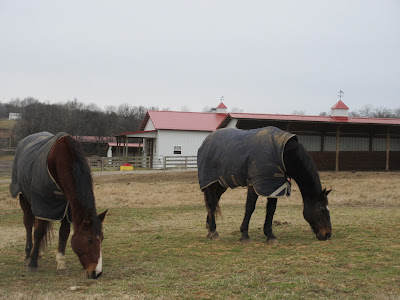the bales that were sampled today
Fortunately there is a way to quantify the nutrients your horse is currently receiving from forage. This requires taking regular forage samples and sending them off for analysis so that you or someone at your feed store can read the results and quantify what may or may not need to be added to your horse's diet. Whenever we switch fields and/or switch cuttings; in other words whenever we have a significant change in forage quality we send a sample away so we know where we stand from a nutrition perspective. Contrary to popular opinion taking and sending a forage sample is not difficult to do, it's not a time consuming procedure, and it's not expensive other than possibly the initial cost of acquiring a hay probe.
Jason's hay probe
If you Google the term hay probe you will quickly see that there are A LOT of different probes on the market today. All of them have a long list of potential benefits and detriments, far longer than you might initially believe would be possible on such a simple tool. Frankly I don't have any strong feelings about which probe is the best except to say that I strongly prefer those that attach to either a power drill or a brace and bit as opposed to those you force into a bale with the strength of your arm. As you can see from the photo I opted for a brace and bit rather than a power drill attachment. There are a couple reasons for this. I want to make taking a forage sample as easy as possible so I'll do it a lot and in a timely fashion. I seem to struggle more than I should to keep batteries charged for my power drills. With a brace and bit I don't have to worry about that so long as I can twist the brace with my arm. Longevity is the other reason. I've used this outfit in commercial applications for eighteen years and I've never had to replace any part of it. I would guess this rig has taken upwards of a thousand samples in that time frame, so the initial $200 cost of the probe, brace and bit is negligible at this point.
hay probe in the bale to get a core sample
hay sample bagged and ready to be sent to Equi-Analytical
Every lab will have a number of options in terms of which nutrients you want tested and which methodologies you want used for the test. If we are totally unsure about what we're sending them we usually choose a basic wet chemistry equine package that gives us macro minerals, some trace minerals, protein and energy (calories) levels. Wet chemistry is more accurate and slower than running the samples through a spectroscopy machine (NIR), but if you know what you're sending to the lab and can quantify it the difference in results is usually not large and the cost of an NIR package is a fraction of the same package of nutrients done via wet chemistry. Because we are familiar with the hay we're sending to Equi-Analytical we usually choose the $28.00 NIR/Plasma Spectroscopy package (they call it the Equi-Tech package).
the Equi-Analytical form to complete and send with the hay sample
All that is left to do is mail the sample to Equi-Analytical and wait for the results.
__________________________________
Lofty and Asterik
Faune and Cocomo
Lucky and Lightning
Clayton and River
Donovan and Oskar eating breakfast
World's Cutest Fainting Goats are in full shedding mode
Roho
Rubrico and Rocky
Toledo, Kennedy and Walon
Romeo and Donneur
Johnny and B-Rad




















3 comments:
Thank you for this very useful and informative post.
Does it take a lot of strength to use the hay corer? Also, do you ever send in hay cubes or pellets for testing?
Very interesting post. I live 45 min west of Syracuse. Our NY State Fair is held there.
Val, not hard at all, especially if you choose the one of the models that fits on a heavy duty cordless drill. Hay pellets usually come with some nutrition information attached; at least in theory they aren't supposed to vary below the minimums so we often use standardized analysis for them. If we used hay pellets as a significant part of our forage source we would definitely test them and I would pay to have the first analysis done via wet chemistry so I was sure of the results.
Jason
Post a Comment